9.2: Metal Allyl and Diene Complexes
- Page ID
- 172774
Learning Objectives
In this lecture you will learn the following
- The metal−allyl complexes.
- The metal−diene complexes.
- The metal−cyclobutadiene complexes.
- The respective metal−ligand interactions.
The allyl ligand is often referred to as an “actor” ligand rather than a “spectator” ligand. It binds to metals in two ways i.e. in a η1 (monohapto) form and a η3 (trihapto) form (Figure \(\PageIndex{1}\)). (i). In its monohapto (η1) form, it behaves as an anionic 1e−donor X type of a ligand analogous to that of a methyl moiety while (ii) in a trihapto (η3) form, it acts as an anionic 3e−donor LX type of a ligand.

Metal−allyl interaction
Of particular interest are the molecular orbitals namely Ψ1, Ψ2 and Ψ3 of the allyl ligand that interact with the metal in a metal allyl complex. The energy of these molecular orbitals increase with the increase in the number of nodes. Of the three, the Ψ1 and Ψ2 orbitals usually engage in ligand to metal σ−donation, with Ψ1 involving in a dative L−type bonding and Ψ2 participating in a covalent X−type bonding with the metal d orbitals (Figure \(\PageIndex{2}\)).
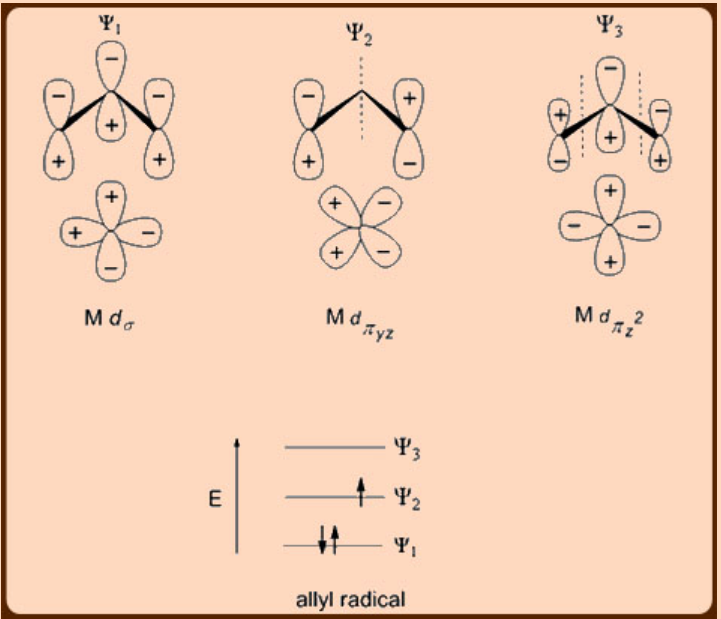
Synthesis of the metal allyl complexes
The metal allyl complexes are synthesized by the following methods.
i. From an alkene complex as shown below.
\[\ce{Mo(dpe)2(η2 -propene) <=> Mo(dpe)2( η3-allyl)H} \nonumber \]
ii. By a nucleophilic attack of an allyl compound as shown below.

iii. By an electrophilic attack of an allyl compound as shown below.
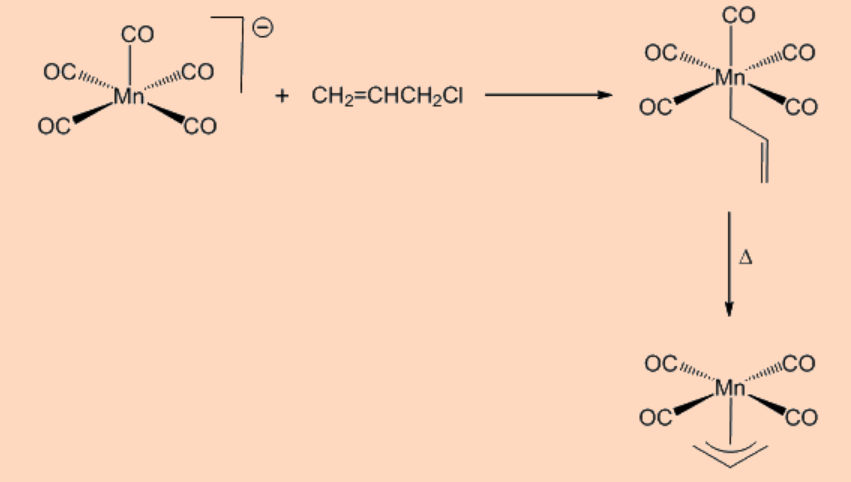
iv. From a diene complex as shown below.

Reactions of metal allyl complexes
The reactivities of the metal allyl complexes toward various species are illustrated below.
i. Reaction with nucleophiles

ii. Reaction with electrophiles

iii. Insertion reaction

iv. Reductive elimination
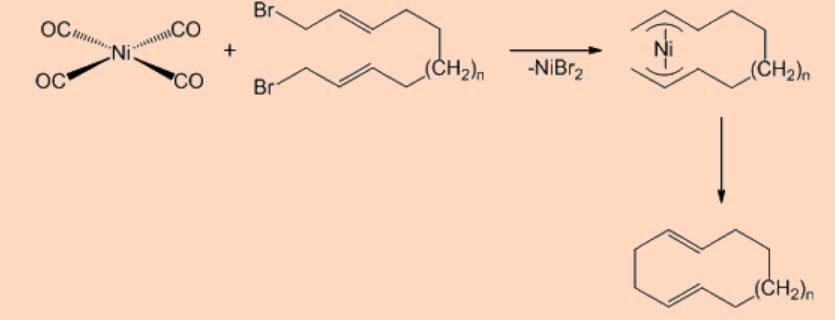
Diene complexes
1,3−Butadiene is a 4e−donor ligand that binds to a metal in a cisoid conformation. The Dewar−Chatt model, when applied to 1,3−butadiene, predicts that the ligand may bind to metal either as a L2 (π2) donor type, similar to that of an alkene, or as an LX2 (σ2π) donor type, similar to that of a metalacyclopropane form. The L2 binding of 1,3−butadiene is rare, e.g. asin (butadiene)Fe(CO)3, while the LX2 type binding is more common, e.g. as in Hf(PMe3)2Cl2. An implication of the LX2 type binding is in the observed shortening of the C2−C3 (1.40 Å) distance alongside the lengthening of the C1−C2(1.46 Å) and C3−C4 (1.46 Å) distances (Figure \(\PageIndex{3}\)).
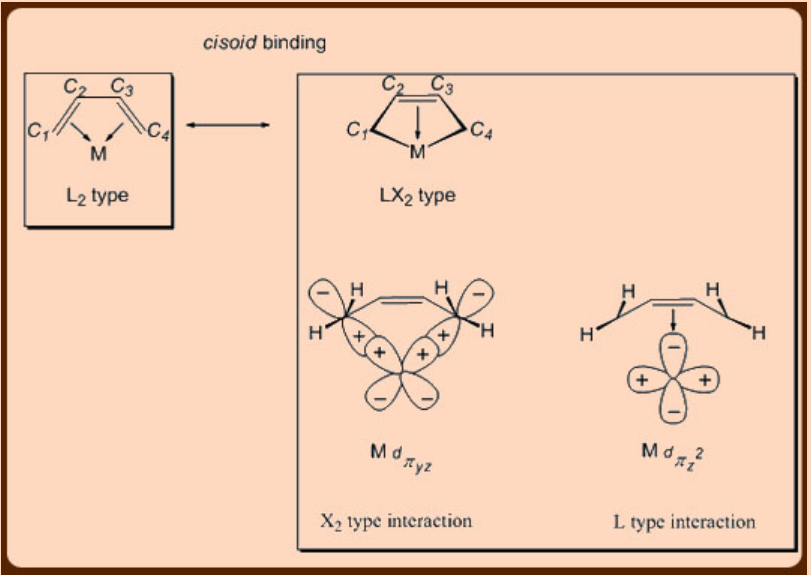
The molecular orbitals of the 1,3−butadiene ligand comprises of two filled Ψ1 (HOMO−1) and Ψ2(HOMO) orbitals and two empty Ψ3 (LUMO) and Ψ4 (LUMO+1) orbitals. In a metal−butadiene interaction the ligand to metal σ−donation occurs from the filled Ψ2 orbital of the 1,3−butadiene ligand while the metal to ligand π−back donation occurs on to the empty Ψ3 orbital of the 1,3−butadiene ligand (Figure \(\PageIndex{4}\)).
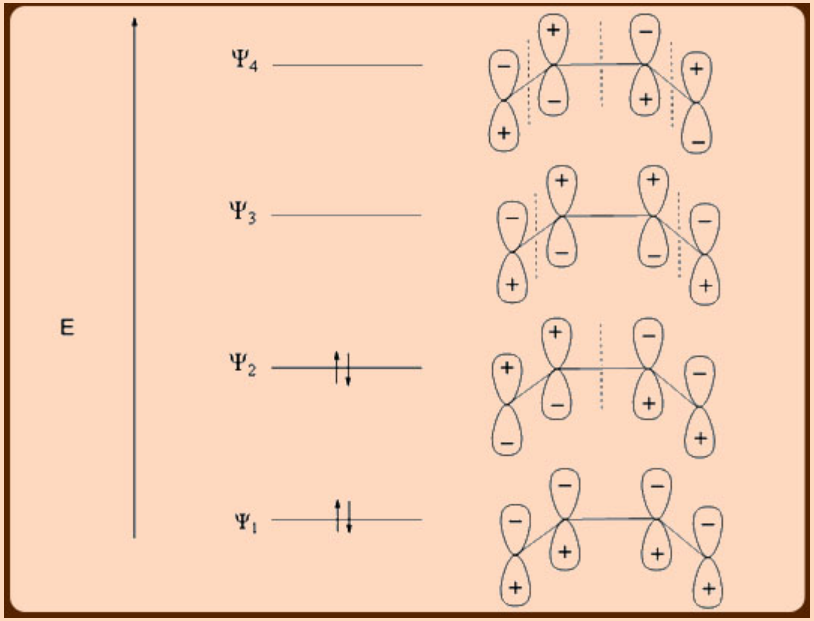
Though cisoid binding is often observed in metal butadiene complexes, a few instances of transoidbinding is seen in dinuclear, e.g. as in Os3(CO)10(C4H6), and in mononuclear complexes e.g. as in Cp2Zr(C4H6) (Figure \(\PageIndex{5}\)).
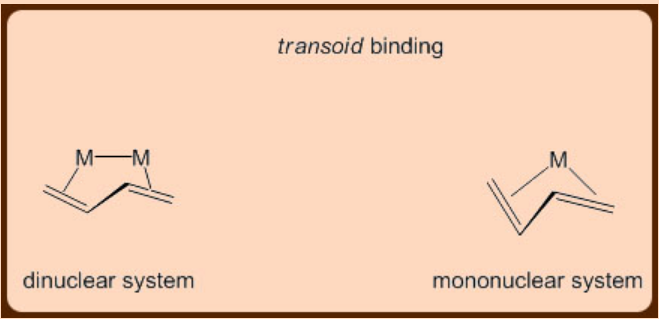
Synthesis of metal butadiene complex
Metal butadiene complexes are usually prepared by the same methods used for synthesizing metal alkene complexes. Two noteworthy synthetic routes are shown below.
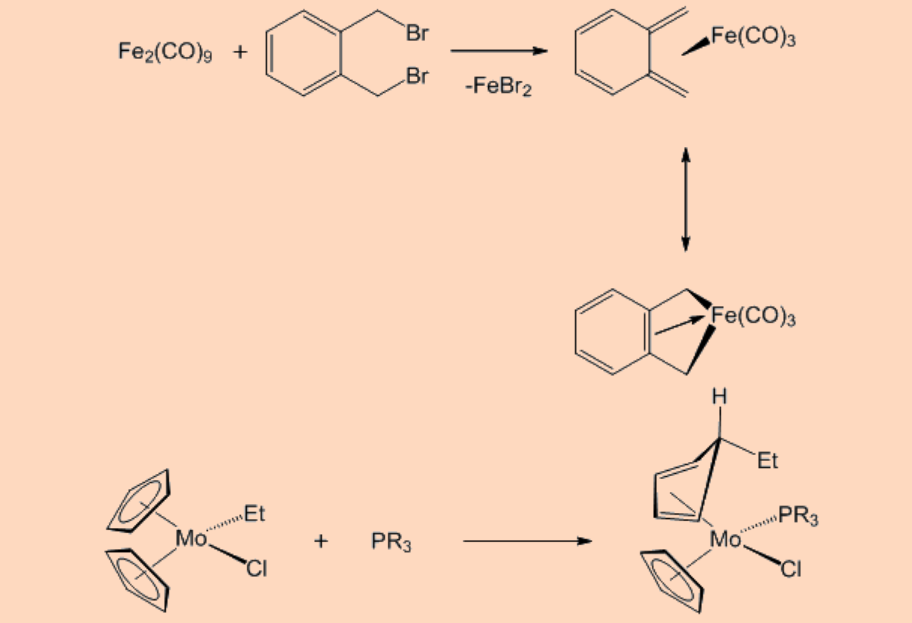
Metal cyclobutadiene complexes
Cyclobutadiene is an interesting ligand because of the fact that its neutral form, being anti−aromatic (4π−electrons), is unstable as a free molecule (Figure \(\PageIndex{6}\)), but its dianionic form is stable because of being aromatic (6π−electrons). Consequently, the cyclobutadiene ligand is stabilized by significant metal to ligand π−back donation to the vacant ligand orbitals.

A synthetic route to metal cyclobutadiene complex is shown below.

Problems
1. The hapticities displayed by an allyl moiety in binding to metals are?
Ans: 1 and 3.
2. Identify which molecular orbitals of an allyl moiety engage in σ−interaction with a suitable d orbital of a metal in a η3−metal allyl complex?
Ans: Ψ1 and Ψ2.
3. Predict the product of the reaction.

Ans:

4. Identify which molecular orbitals of a butadiene moiety engage in σ−interaction with a suitable dorbital of a metal in a η4−metal butadiene complex?
Ans: Ψ2.
Self Assessment test
1. Predict the product of the reaction.
\[\ce{<(--Ni--)> + CO2 -> } \nonumber \]
Ans:
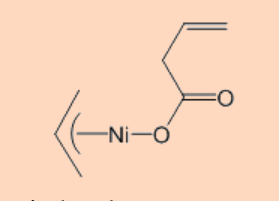
2. Identify which molecular orbitals of a butadiene moiety engage in π−interaction with a suitable dorbital of a metal in a η4−metal allyl complex?
Ans: Ψ3.
3. Mention the type of orientations displayed by butadiene ligands for binding to metal.
Ans: Cisoid (common) and transoid (rare).
4. Comment on the number of π−electrons present in the cyclobutadiene moiety of a metal cyclobutadiene complex.
Ans: 6 π−electrons.
Summary
Allyl, 1,3−butadiene and cyclobutadiene together constitute an important class of σ−donor/π−acceptor ligands that occupy a special place in organometallic chemistry. The complexes of these ligands with metals are important intermediates in many catalytic cycles and hence an understanding of their interaction with metal is of significant importance. In this context, the synthesis, characterization and the reactivities of the organometallic complexes of these ligands are described alongside the respective metal−ligand interactions.


